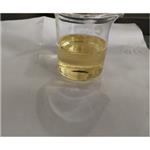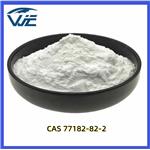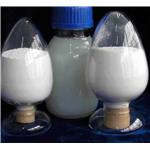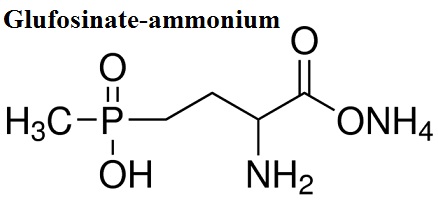- Glufosinate ammonium
-

- $0.00 / 1kg
-
2024-02-22
- CAS:77182-82-2
- Min. Order: 1kg
- Purity: 97%
- Supply Ability: 20000
- Glufosinate ammonium
-

- $180.00 / 1KG
-
2023-08-16
- CAS:77182-82-2
- Min. Order: 1KG
- Purity: >99%
- Supply Ability: 50000kg/Month
- Glufosinate-ammonium
-

- $20.00 / 1kg
-
2023-08-11
- CAS:77182-82-2
- Min. Order: 1kg
- Purity: 99.99%
- Supply Ability: 50000tons
|
| | Glufosinate-ammonium Chemical Properties |
| Melting point | 210°C | | Boiling point | 519℃ | | density | 1.4 g/cm3 | | Fp | 100 °C | | storage temp. | Keep in dark place,Inert atmosphere,2-8°C | | solubility | Methanol (Slightly), Water (Soluble) | | pka | 9.15[at 20 ℃] | | color | White to Beige | | Water Solubility | Soluble in water | | Merck | 13,7425 | | BRN | 8163399 | | Stability: | Stable. Incompatible with strong oxidizing agents. | | InChIKey | ZBMRKNMTMPPMMK-UHFFFAOYSA-N | | LogP | -4.01 at 25℃ | | CAS DataBase Reference | 77182-82-2(CAS DataBase Reference) | | EPA Substance Registry System | Glufosinate-ammonium (77182-82-2) |
| | Glufosinate-ammonium Usage And Synthesis |
| Organophosphorus herbicides | Glufosinate-ammonium, also known as glufosinate, is a non-selective foliar application of organic phosphorus herbicide, in 1979 first developed by the Federal Republic of Germany Hoechst (Hoechst) chemical synthesis company. Weeding mechanism of Glufosinate-ammonium is absorbed by the blade, having a part suction effect, can be transferred from the base of the blade to the ends, transferred less to other parts of the plant, is harmless for not unearthed shoots and seeds. Plants Glufosinate-ammonium metabolism is disordered in a short period after drug application, a strong cytotoxic agent Glufosinate-ammonium ion is accumulated in plants; poisoned the plant to die. While also severely inhibited photosynthesis, injured plants was yellowish white after lose of the green, after 2 to 5 days, turned yellow and died. After contacted with the soil, lost activity, it should only for spray of stem and leaf at postemergence.
Applications: Glufosinate-ammonium is mainly used for destuctive weeding of orchards, vineyards, potato fields, nurseries, forests, pastures, ornamental shrubs and free arable, prevention and weeding of annual and perennial weeds such as foxtail, wild oats, crabgrass , barnyard grass, green foxtail, bluegrass, quackgrass, bermudagrass, bentgrass, reeds, fescue, etc. Also prevention and weeding of broadleaf weeds such as quinoa, amaranth, smartweed, chestnut, black nightshade, chickweed, purslane, cleavers, sonchus, thistle, field bindweed, dandelion, also have some effect on sedges and ferns. When broadleaf weeds in the beginning of growing season and grass weeds in tillering period, dosage of 0.7 to 1.2 kg/hectare was sprayed on weed populations, period of weed control is 4 to 6 weeks, administration again if necessary, can significantly extend the validity period. Potato field should be used in the pre-emergence, it can also be sprayed before harvest, killing and weeding ground stubble, so as to harvest. Prevention and weeding of ferns, dosage of per hectare is 1.5 to 2 kg. Usually alone, sometimes it can also be mixed with simajine, diuron or methylchloro phenoxyacetic acid, and so on.

Figure 1 The chemical structural formula of Glufosinate-ammonium.
The above information is edited by the chemicalbook of Liu Yujie. | | Toxicity | Male rats acute oral LD50 is 2000 mg/kg, female rats is 1620 mg/kg; male mice acute oral LD50 is 431 mg/kg, female mice is 416 mg/kg; dog acute oral LD50 is 200~400 mg/kg. Male rats acute percutaneous LD50 is > 2000 mg/kg, female rats is 4000 mg/kg. No teratogenic and carcinogenic effects. Rainbow trout LC50 is 320mg/L (96h). | | Chemical properties | Low solubility in common organic solvents, solubility in water is large. At pH 5-9, hydrolysis, half-life of soil is <10d. Light stability. | | Uses | Organophosphorus herbicides, glutamine synthetase inhibitors, non-selective contact herbicide. There are certain suction effect, can be used for weeding of orchards, vineyards and non-cultivated land, can also be used for prevention and weeding of annual and perennial dicotyledonous weeds and sedges in potato field, such as rat tail foxtail, crabgrass, barnyardgrass, foxtail, wild wheat, wild corn, cocksfoot, fescue, deschampsia flexuosa, hair grass, ryegrass, reed, bluegrass, wild oat, brome, cleavers, henbit, lamium, solanum nigrum, chickweed, quackgrass, bentgrass, calamagrostis grass, field forget-grass, bermuda grass, amaranthus. Depending on crops and weeds, the amount of use varies, the usage amount of per hectare is 1~2 kg or more , such as prevention and weeding of raspberry crops and fern in forests and alpine pastures. Usage amount is 1.5~20kg/hm2. | | Production methods | The O, O-diethyl methyl phosphonate reacted with dibromoethane reaction, heated at 80 ℃ for 2 h to get BrCH2CH2P (O) (OC2H5) CH3, and then reacted with (C2H5O2C) 2CNa (NHCOCH3) at 85 ℃to get ( C2H5O2C) 2C (NHCOCH3) CH2CH2P (O) (OC2H5) CH3, which was refluxed with hydrochloric acid, the resulting compound reacted with 28% Glufosinate-ammonium hydroxide for 8 h at 60~70 ℃ to obtain Glufosinate-ammonium.
In addition, synthesis of Glufosinate-ammonium included high-pressure catalytic synthesis method, low-temperature of targeting synthesis, using Strecker reaction and Mitchell addition process ,and so on. See "Pesticides" issue 9, 2002. | | Description | Glufosinate ammonium is a broad-spectrum contact killing herbicide with the chemical formula c5h15n2o4p and the amount of chemical formula 198.16. It has the characteristics of wide herbicidal spectrum, low toxicity, high activity and good environmental compatibility. It is one of the most widely-applied broad-spectrum herbicides, controlling weeds in a huge variety of crops worldwide. Its unique mode of action makes it ideal to be used in rotation with other herbicides to mitigate weed resistance. | | Chemical Properties | It is characterized as a highly soluble and volatile white to light yellow crystalline solid with a slightly pungent odor, and exposure occurs by inhalation, ingestion, or contact. It is hydrolyzed when the pH value is 5-9, and the half-life in soil is <10d. Stable to light. | | Uses | Used as a herbicide that can be applied post-emergence in noncrop areas and as a directed spray in field-grown and container nursery stock. It is nonselective and controls a broad spectrum and annual and perennial grass and broadleaf weeds. | | Agricultural Uses | Herbicide: Glufosinate-ammonium is a naturally occurring
broad-spectrum contact herbicide that is used to control
a wide range of weeds after the crop emerges or for total
vegetation control on non-crop lands. It is used on crops
that have been genetically engineered. Glufosinate herbicides are also used to desiccate crops before harvest. | | Trade name | BASTA®; DERRINGER®; FINALE®;
HOE 00661®; HOE 03986®; HOE 39866®; IGNITE®;
LIBERTY®; RELY®; REMOVE®; RUBOUT®;
TOTAL® | | Safety Profile | A poison by ingestion,subcutaneous, and intraperitoneal routes. Low toxicity byskin contact. Human systemic effects by ingestion: bloodpressure lowering, change in motor activity, coma,cyanosis. When heated to decomposition it emits toxicvapors of NO | | Mode of action | Glufosinate-ammonium is a plant protection product that works by inhibiting an enzyme central to plant metabolism. Plants absorb this substance primarily through their leaves and other green parts. As a contact herbicide, Glufosinate-ammonium is effective only where it comes into contact with the plant. This allows it to control weeds without affecting the roots or requiring tillage, which is important especially for erosion-prone areas such as slopes. |
| | Glufosinate-ammonium Preparation Products And Raw materials |
|